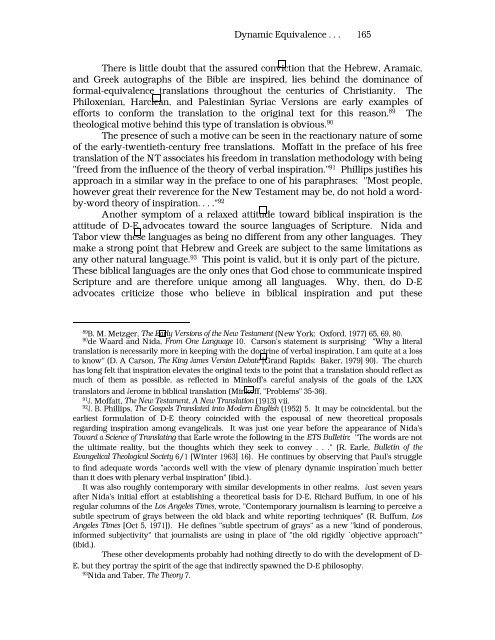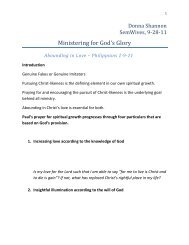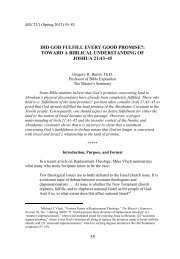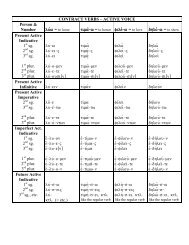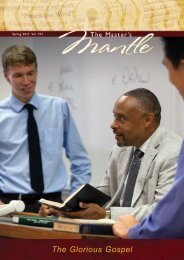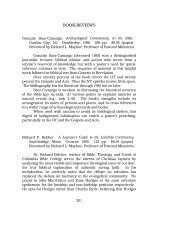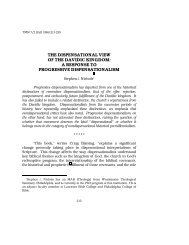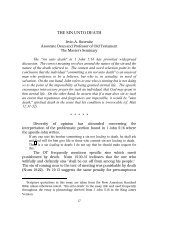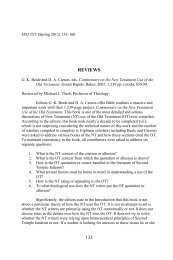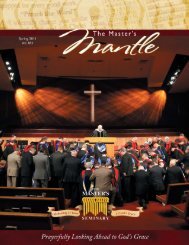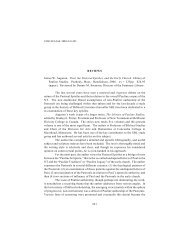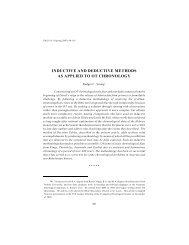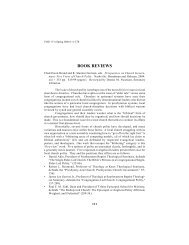dynamic equivalence: a method of translation or a system
dynamic equivalence: a method of translation or a system
dynamic equivalence: a method of translation or a system
- No tags were found...
You also want an ePaper? Increase the reach of your titles
YUMPU automatically turns print PDFs into web optimized ePapers that Google loves.
Dynamic Equivalence . . . 165There is little doubt that the assured conviction that the Hebrew, Aramaic,and Greek autographs <strong>of</strong> the Bible are inspired, lies behind the dominance <strong>of</strong>f<strong>or</strong>mal-<strong>equivalence</strong> <strong>translation</strong>s throughout the centuries <strong>of</strong> Christianity. ThePhiloxenian, Harclean, and Palestinian Syriac Versions are early examples <strong>of</strong>eff<strong>or</strong>ts to conf<strong>or</strong>m the <strong>translation</strong> to the <strong>or</strong>iginal text f<strong>or</strong> this reason. 89 Thetheological motive behind this type <strong>of</strong> <strong>translation</strong> is obvious. 90The presence <strong>of</strong> such a motive can be seen in the reactionary nature <strong>of</strong> some<strong>of</strong> the early-twentieth-century free <strong>translation</strong>s. M<strong>of</strong>fatt in the preface <strong>of</strong> his free<strong>translation</strong> <strong>of</strong> the NT associates his freedom in <strong>translation</strong> <strong>method</strong>ology with being"freed from the influence <strong>of</strong> the the<strong>or</strong>y <strong>of</strong> verbal inspiration." 91 Phillips justifies hisapproach in a similar way in the preface to one <strong>of</strong> his paraphrases: "Most people,however great their reverence f<strong>or</strong> the New Testament may be, do not hold a w<strong>or</strong>dby-w<strong>or</strong>dthe<strong>or</strong>y <strong>of</strong> inspiration. . . ." 92Another symptom <strong>of</strong> a relaxed attitude toward biblical inspiration is theattitude <strong>of</strong> D-E advocates toward the source languages <strong>of</strong> Scripture. Nida andTab<strong>or</strong> view these languages as being no different from any other languages. Theymake a strong point that Hebrew and Greek are subject to the same limitations asany other natural language. 93 This point is valid, but it is only part <strong>of</strong> the picture.These biblical languages are the only ones that God chose to communicate inspiredScripture and are theref<strong>or</strong>e unique among all languages. Why, then, do D-Eadvocates criticize those who believe in biblical inspiration and put these89B. M. Metzger, The Early Versions <strong>of</strong> the New Testament (New Y<strong>or</strong>k: Oxf<strong>or</strong>d, 1977) 65, 69, 80.90de Waard and Nida, From One Language 10. Carson's statement is surprising: "Why a literal<strong>translation</strong> is necessarily m<strong>or</strong>e in keeping with the doctrine <strong>of</strong> verbal inspiration, I am quite at a lossto know" (D. A Carson, The King James Version Debate [Grand Rapids: Baker, 1979] 90). The churchhas long felt that inspiration elevates the <strong>or</strong>iginal texts to the point that a <strong>translation</strong> should reflect asmuch <strong>of</strong> them as possible, as reflected in Mink<strong>of</strong>f's careful analysis <strong>of</strong> the goals <strong>of</strong> the LXXtranslat<strong>or</strong>s and Jerome in biblical <strong>translation</strong> (Mink<strong>of</strong>f, "Problems" 35-36).91J. M<strong>of</strong>fatt, The New Testament, A New Translation (1913) vii.92J. B. Phillips, The Gospels Translated into Modern English (1952) 5. It may be coincidental, but theearliest f<strong>or</strong>mulation <strong>of</strong> D-E the<strong>or</strong>y coincided with the espousal <strong>of</strong> new the<strong>or</strong>etical proposalsregarding inspiration among evangelicals. It was just one year bef<strong>or</strong>e the appearance <strong>of</strong> Nida'sToward a Science <strong>of</strong> Translating that Earle wrote the following in the ETS Bulletin: "The w<strong>or</strong>ds are notthe ultimate reality, but the thoughts which they seek to convey . . ." (R. Earle, Bulletin <strong>of</strong> theEvangelical Theological Society 6/1 [Winter 1963] 16). He continues by observing that Paul's struggleto find adequate w<strong>or</strong>ds "acc<strong>or</strong>ds well with the view <strong>of</strong> plenary <strong>dynamic</strong> inspiration`much betterthan it does with plenary verbal inspiration" (ibid.).It was also roughly contemp<strong>or</strong>ary with similar developments in other realms. Just seven yearsafter Nida's initial eff<strong>or</strong>t at establishing a the<strong>or</strong>etical basis f<strong>or</strong> D-E, Richard Buffum, in one <strong>of</strong> hisregular columns <strong>of</strong> the Los Angeles Times, wrote, "Contemp<strong>or</strong>ary journalism is learning to perceive asubtle spectrum <strong>of</strong> grays between the old black and white rep<strong>or</strong>ting techniques" (R. Buffum, LosAngeles Times [Oct 5, 1971]). He defines "subtle spectrum <strong>of</strong> grays" as a new "kind <strong>of</strong> ponderous,inf<strong>or</strong>med subjectivity" that journalists are using in place <strong>of</strong> "the old rigidly `objective approach'"(ibid.).These other developments probably had nothing directly to do with the development <strong>of</strong> D-E, but they p<strong>or</strong>tray the spirit <strong>of</strong> the age that indirectly spawned the D-E philosophy.93Nida and Taber, The The<strong>or</strong>y 7.


